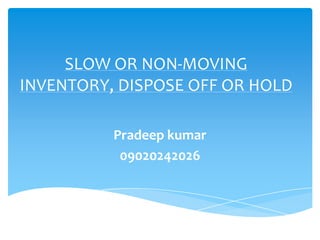
CALCULATE SLOW OR NON-MOVING INVENTORY COSTS
- 1. SLOW OR NON-MOVING INVENTORY, DISPOSE OFF OR HOLD Pradeep kumar 09020242026
- 2. High value of slow moving and non-moving items, concerns blocked huge sum of money unnecessarily in raw materials. To overcome this problem, it is necessary to dispose-off as early as possible the non-moving items or make arrangements for their exchange with the Raw materials required by the concern. Besides this, no new requisition should be made for the purchase of slow moving items, till the existing stock is exhausted. Computation of inventory carrying cost is used to identify slow moving items Slow or Non-moving Inventory
- 3. The cost to carry inventory measures the overhead that an organization carries to support its inventory. In addition to the money originally spent to purchase it, more money will be spent on upkeep while inventory sits in your possession. Inventory carrying cost
- 4. The longer the inventory is there, the more it will cost in upkeep. Carrying cost is usually expressed as a percentage that will be spent on inventory overhead per year. Inventory carrying cost
- 5. If inventory carrying cost is more means that good should be removed from inventory. In non-moving inventory arriving at the minimum or optimum price at which such stocks can be disposed off. Any price higher than ICC would be profitable for the company. In order to arrive at breakeven point
- 6. I) Inventory carrying cost (storage, insurance, supervision, etc.) ii) Probable deterioration in quality - money value of such loss; iii) Interest on money tied up in such inventory; iv) Opportunity cost (or transfer earning) of money locked up. Break even point
- 7. I) Inventory Carrying Rate: This can best be explained by the example below.... 1. Add up your annual Inventory Costs: Example: $800k = Storage $400k = Handling $600k = Obsolescence $800k = Damage $600k = Administrative $200k = Loss (pilferage etc.) $3,400k Total 2. Divide the Inventory Costs by the Average Inventory Value: Example: $3,400k / $34,000k = 10% Calculation of Inventory Carrying Cost
- 8. 3. Add up your: 9% = Opportunity Cost of Capital (the return you could reasonably expect if you used the money elsewhere) 4% = Insurance 6% = Taxes 19% 4. Add your percentages: 10% + 19% = 29% Your Inventory Carrying Rate = 29% Calculation of Inventory Carrying Cost
- 9. Calculation of Inventory Carrying Cost II) Inventory Carrying Costs: Inventory Carrying Cost = Inventory Carrying Rate (see above) X Average Inventory Value Example: $9,860,000 = 29% X $34,000,000
- 10. Thank you